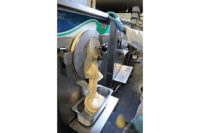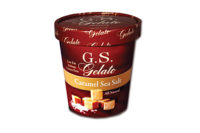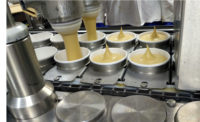Few dairy foods are merchandised as beautifully as gelato. Think about it. Milk is sold in a bottle, yogurt in a cup. Admittedly, you can find grace in the swirls of a soft-serve ice cream cone, and a talented barista can draw a decorative image in the foam of a cappuccino. But the presentation that best exemplifies the phrase “we eat with our eyes” belongs to that found in a gelateria.
A gelateria is no run-of-the-mill scoop shop with 3-gallon cardboard cartons nestled in the bottom of an ice cream freezer. Far from it. Here, shallow 2.5-liter pans in a dipping cabinet are tilted at an angle toward the shopper. In each pan, the ice cream has been mounded into peaks and adorned with a fresh strawberry, a biscotti or a drizzle of caramel. Who can resist?
Not me. One day I passed a gelato shop, stopped to admire the presentation and found myself buying a cup. Later, in speaking with the owner, I learned that G.S. Gelato is the supplier.
“G” is Guido Tremolini and “S” is Simona Faroni. Twenty years ago, Tremolini was running a restaurant in Italy and his wife was selling Redken hair products there. There are 100 gelato shops in his home town, Tremolini said. On a trip to Florida to visit friends in the 1990s, the husband and wife noticed the lack of stores and restaurants selling gelato.
To Italians, food is in their genes, Faroni said. “Everyone grows up in the kitchen, and food is a passion.” But Americans have a different view of food, she noted. In Italy, one “eats to nourish the self” while in the United States, one uses food “to feed the self,” she said.
Italians appreciate good quality food and its artful presentation, and Faroni said she wanted to bring the passion for great food to the United States. She and her husband would do that by making authentic Italian gelato with fresh, quality ingredients. Their timing was perfect. Americans were starting to appreciate good food, Faroni said, and they were beginning to seek food with higher nutritional values than fast foods and processed foods. It might not be a “better-for-you” frozen dessert option, but gelato does not have as high of a fat content as ice cream.
In 1996, Tremolini and Faroni moved to the United States. They spoke no English. It was as if they were re-born in another country, Faroni said. The Italians knew no bankers or investors in the United States and knew nothing about the rules and regulations about wholesaling frozen desserts in Florida. They had a rude awakening.
Essentially, Tremolini thought he could plug in his Italian-made processing equipment and start wholesaling. The Florida Department of Agriculture woke him up to the realities of sanitation, food safety and good manufacturing practices. Gary Newton, an environmental administrator with the department’s Bureau of Dairy Industry, said that European equipment is designed to make product but isn’t designed with sanitation in mind. For example, he explained that because the agitator well was not sealed, ice cream mix could leak into unreachable places that could not be sanitized.
Faroni and Tremolini have a saying: “When the water comes up to your throat, you better start swimming.” For 14 months they worked with Newton’s department to re-design the equipment to meet Florida’s standards. At the same time, they studied English by attending night classes and reading the newspaper every day. (Not only did they learn English, but also they became U.S. citizens. They also maintain citizenship in Italy.)
At last the equipment was approved. Faroni said she was surprised (pleasantly) that a government agency helped them to start their business by teaching them how to meet code. It doesn’t work that way in Italy, she said. She credits Newton for their success, but he demurs. “They did everything we asked them to do,” Newton said.
A strategy to grow
Once they obtained the permits to process gelato for wholesale distribution, Tremolini and Faroni went full steam ahead and moved into a larger facility. (See related article on page 64.) They have been deliberate in their approach to growth. Their strategy is to create branded and private-label products in all of the markets they serve and with each product they manufacture (gelato, sorbet and frozen yogurt). They sell to retail and foodservice accounts.
In 2011, G.S. Gelato created a division called Yogurtiamo. Ti amo is Italian for “I love you.” Yogurtiamo can also mean “let’s yogurt.” G.S. Gelato sells one-gallon plastic jugs of frozen yogurt mix to stores, restaurants and theme parks. Among the more than 50 flavors are blueberry pomegranate, blood orange and cookies and cream.
The market for gelato is getting larger, observed Cynthia Harrison, the director of business development, who works closely with grocery store chains. She said retail stores are adding doors for the product. Foodservice operators, especially those with Italian concepts, want to add gelato to their menus.
Both Tremolini and Faroni welcomed the news in March that Häagen-Dazs (owned by international food giant Nestle) is selling gelato. “It validates what we’ve been doing,” Faroni said.
G.S. Gelato positions its gelato against super-premium ice cream. The density of the gelato (made with milk and some cream) gives it the same creamy mouthfeel as ice cream. The company also uses other product attributes to appeal to consumers’ interest in health and nutrition. For example, the company promotes gelato as a “better for you” dessert because of its low fat content (versus conventional ice cream). Sorbets are naturally fat-free, gluten-free and dairy-free, and most of the gelato flavors are gluten-free. Seven of the company’s frozen yogurt products have landed on the Florida Hospital Association’s Healthy 100 list, which promotes low-calorie, low-fat and low-sugar foods.
On the retail side, the company’s main target market is households with children. Teens especially like gelato, said Marketing Manager Emily Rodgers, which is confirmed by an analysis from Mintel, the Chicago-based international research firm. A July 2012 report of the ice cream and frozen novelty market in the United States found that the 18- to 34-year-old age group is most likely to eat gelato. This generation (aka “Millenials”) is characterized by “adventurous eaters” who “look for healthier, more natural products; appreciate higher-quality foods; and are ready to experience global flavors. Gelato falls in the global cuisine realm with its Italian roots. The category could be further developed using global flavors.”
Gelato consumers also tend to have higher incomes, Mintel found, probably because of gelato’s positioning as a super-premium treat and resulting higher price. To appeal to lower-income households, “gelato and frozen yogurt brands will need to make inroads into lower-price grocery stores, or private-label will need to delve further into these segments,” Mintel stated.
In fact, G.S. Gelato has a good private-label business. It processes gelato for several national and regional grocery store chains. One chain had been importing gelato before sourcing it from G.S. Gelato.
G.S. Gelato also supplies restaurant chains (including its own stores) with custom-developed flavors and dessert presentation ideas. G.S. Gelato’s retail business is called San Gelato Café, which serves sandwiches, salads and coffees, in addition to gelato, sorbet and frozen yogurt. The owners operate four stores on Florida’s Emerald Coast.
Customer service
The owner of the gelateria where I bought a cup of gelato told me she turned to G.S. Gelato as a supplier for several reasons. She likes the “from scratch” recipes, the taste and flavors of the gelatos, and the company’s emphasis on food safety, especially the SQF certification. G.S. Gelato is strong on customer service, she said. When there were pistachio and peanut butter contamination scares a few years ago, G.S. Gelato immediately notified her that it was not sourcing product from the affected suppliers. (Dairy Foodsagreed not to identify the customer because of G.S. Gelato’s confidentiality agreement with her.)
While G.S. Gelato does have foodservice distribution in the West, the company considers itself stronger in the Southeast, the Northeast and the Midwest. It exhibits at industry shows including the PLMA’s Private Label Show, the National Frozen and Refrigerated Foods Association convention, the Florida Restaurant and Lodging Show and the International Dairy Deli Bake Association show. It has exhibited at the Fancy Food Show, where it won a sofi gold award in 2010 for its blood orange sorbet.
A canvas for flavors
Tremolini said he has thousands of recipes he can use in branded and private-label product. The company keeps a watch on trends in alcohol beverages because the flavors used there will influence gelato.
Gelato seems more receptive to unconventional flavors than ice cream. “You can take risks in gelato that you won’t with ice cream,” Harrison said. She cited fig ripple as one example. Other recent flavors include caramel with sea salt, biscotti, blood orange and pumpkin.
Even though it has a vast number of recipes in its library, G.S. Gelato will start from scratch to develop a flavor for a client. Tremolini researches ingredients to find the exact ones to meet a client’s taste and budget requirements. G.S. Gelato takes pride in its custom approach.
“We offer seamless development, from ideation to the shelf,” Rodgers said.
Tremolini works on flavor concepts every day. He is known to dash out of his lab, run into co-workers’ offices and plunk down samples for them to taste.
“Our core value is not just manufacturing,” Faroni said. “We create, develop, partner and offer custom solutions in flavors, formulations, packaging, packing, equipment and training. We have an in-house marketing and graphics department that retail stores and restaurants retail stores can use.”
The company has even designed refrigerated cases for stores and restaurants.
“We never sit back,” Faroni said. “We react to change quickly and are the cutting edge of packaging, formats and diversity.”
In talking about gelato, ingredients, flavors and processing, Tremolini and Faroni use the word “authenticity” over and over. Despite living in the United States for nearly 20 years, they stay true to their Italian roots in some aspects. Exhibit A is the 50-year-old Faema machine in the office used to make a cup of authentic Italian espresso. No one but Tremolini is allowed to operate it.
That’s not to say the husband and wife haven’t picked up American ways. Faroni has been bitten by the fitness bug; she runs 6 miles in the morning before coming to the office. Tremolini has acquired a barbecue habit since settling in the Florida panhandle.
For lunch, we ate at Sonny’s Real Pit Bar-B-Q where Tremolini dug into the staples of Southern fare: ribs, corn on the cob and hush puppies. I won’t be surprised if I see gelato on the menu there next time I’m in Fort Walton Beach.








